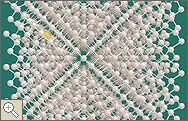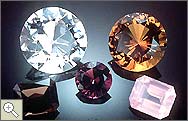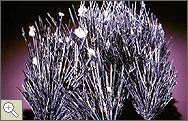
Minerals: The Building Blocks
Born of fluid, heat, and pressure, minerals dazzle us with their breathtaking colors and shapes and astonish us with their usefulness. They are forged underground, where forces that have been at work for billions of years continue to make more minerals. A mineral is a naturally occurring, inorganic (nonliving) solid having a specific chemical composition.
When they look for minerals in their own environment, students may find a single mineral specimen such as marble, which is pure calcite. However, they will probably find rocks, which are mixtures of two or more minerals. Granite, for instance, with its tiny multi-colored grains, is made of quartz, feldspar, and mica.
Crystals: The Form
Most minerals occur naturally as crystals. Every crystal has an orderly, internal pattern of atoms, with a distinctive way of locking new atoms into that pattern to repeat it again and again. The shape of the resulting crystaL-such as a cube (like salt) or a six-sided form (like a snowflake)-mirrors the internal arrangement of the atoms. As crystals grow, differences in temperature and chemical composition cause fascinating variations. But students will rarely find in their backyard the perfectly shaped mineral crystals that they see in a museum. This is because in order to readily show their geometric form and flat surfaces, crystals need ideal growing conditions and room to grow. When many different crystals grow near each other, they mesh together to form a conglomerated mass. This is the case with most rocks, such as granite mentioned above, which is made up of many tiny mineral crystals. The museum-quality specimens shown in the images here grew in roomy environments that allowed the geometric shapes to form uninhibited.
The internal arrangement of atoms determines all the minerals' chemical and physical properties, including color. Light interacts with different atoms to create different colors. Many minerals are colorless in their pure state; however, impurities of the atomic structure cause color. Quartz, for example, is normally colorless, but occurs in a range of colors from pink to brown to the deep purple of amethyst, depending on the number and type of impurities in its structure. In its colorless state, quartz resembles ice. In fact, the root for crystal comes from the Greek word krystallos-ice-because the ancient Greeks believed clear quartz was ice frozen so hard it could not melt.
Scientists typically describe crystals as "growing," even though they are not alive. In subterranean gardens, they branch and bristle as trillions of atoms connect in regular three-dimensional patterns. Each crystal starts small and grows as more atoms are added. Many grow from water rich in dissolved minerals, but they also grow from melted rock and even vapor. Under the influence of different temperatures and pressures, atoms combine in an amazing array of crystal shapes. It is this variety and perfection of form and symmetry that has long drawn scientists to the study of minerals.
Symmetry is a regular, repeated pattern of component parts. Symmetry is everywhere in nature-the paired wings of a butterfly, the whorls and petals in a sunflower, the pattern of a snowflake, the legs of a spider-and minerals are no exception. In crystals, these repeated patterns occur within the basic atomic structure and reflect the pattern of faces of the crystal. You often can see the characteristic symmetry of a mineral crystal with the naked eye, but if the crystal is tiny, then you may need to look at it with a magnifying glass or microscope (as will be demonstrated in Lesson Plan 2). Recognizing symmetrical patterns in crystals may be difficult at first, but experience helps: the more specimens you look at, the more symmetry-and crystals-you will recognize. However, some specimens do not have well-formed crystals and are difficult even for experts to classify.
|
 |
 |
 |
 |

The colored atom in the upper left corner is an impurity in the structure of this diamond. Impurities such as this cause the different
colors of diamonds.
|
 |
 |
 |
 |
 |
 |

Miscellaneous Quartz and Gems © Smithsonian Institution
|
 |
 |

Miscellaneous cut quartz gems, showing a range of colors.
|
 |
 |
 |
 |
 |
 |

Stibnite © Smithsonian Institution
|
 |
 |

This stibnite has metallic, needle-like crystals
|
 |
 |
 |
|

